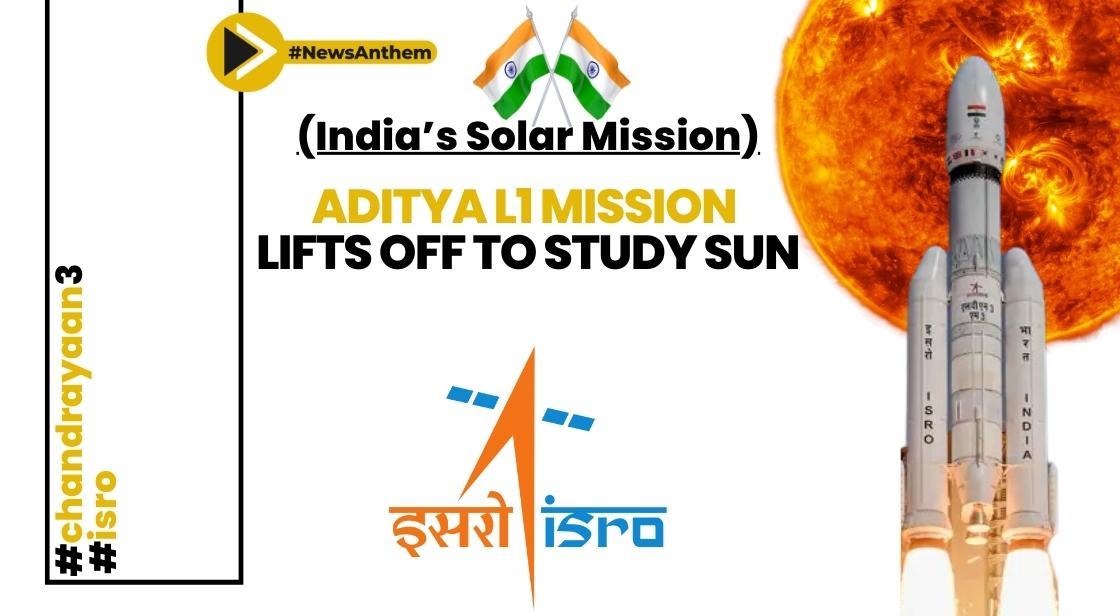India's Solar Mission Aditya L1 Launched Successfully

News Synopsis
ISRO's Aditya-L1 Solar Mission: A Successful Leap in Space Exploration
Just ten days after the historic Chandrayaan-3 lunar landing, the Indian Space Research Organisation (ISRO) has added another feather to its cap with the successful launch of its first solar mission, Aditya-L1. This significant event took place at the Satish Dhawan Space Centre in Sriharikota on September 2, at precisely 11:50 am.
Shedding Light on Solar Winds
The Aditya-L1 mission is a remarkable endeavor aimed at studying solar winds and their potential disturbances on Earth, often observed as mesmerizing auroras. Solar winds, composed of charged particles from the Sun, play a vital role in understanding space weather and its impact on our planet.
India's Lunar Triumph and the Aditya-L1 Mission
India's journey into space exploration has been marked by remarkable achievements. Just last month, India outshone Russia by becoming the first country to land on the south pole of the Moon with the Chandrayaan-3 mission.
Despite Russia's more powerful rocket, India's Chandrayaan-3 exhibited outstanding endurance and executed a textbook landing.
The Unique Orbit of Aditya-L1
The Aditya-L1 spacecraft's mission involves traveling approximately 1.5 million kilometers (930,000 miles) over four months to reach a unique parking spot in space. This location is known as Lagrangian Point 1, where the gravitational forces of Earth and the Sun essentially cancel each other out. This gravitational balance allows the spacecraft to conserve fuel, enabling long-term observation of the Sun, 24/7.
The Importance of Aditya-L1 Data
Former ISRO chairman G Madhavan Nair stressed the significance of data from Aditya-L1 for explaining celestial phenomena and supporting climate change studies. The data gathered from this solar mission will provide valuable insights into the complex processes occurring in the Sun's atmosphere.
India's Thrifty Space Program
India's space program continues to impress the world with its cost-effective and innovative approach. Despite having a relatively low budget compared to established spacefaring nations, India has consistently achieved ambitious space goals.
This is attributed to the country's ability to adapt and refine existing technology, as well as its access to a pool of highly skilled engineers who receive competitive salaries compared to their international counterparts.
A Majestic PSLV Launch
The PSLV-XL (Polar Satellite Launch Vehicle) played a pivotal role in deploying the Aditya L1 spacecraft into space. This mission stands out as one of the longest undertaken by the PSLV, with a deployment duration exceeding 60 minutes.
The PSLV's performance has once again demonstrated its reliability and capability in India's space exploration endeavors.
In the realm of space exploration, ISRO's successful launch of the Aditya-L1 mission underscores India's growing prowess and commitment to advancing scientific knowledge for the betterment of humanity.
Major Science Objectives of the Mission
The Aditya-L1 mission is driven by a set of significant scientific objectives aimed at unraveling the mysteries of the Sun and its impact on space weather and our planet. Here are the major science objectives of the mission:
-
Comprehending Coronal Heating and Solar Wind Acceleration: The mission's foremost goal is to gain a comprehensive understanding of the processes responsible for the heating of the solar corona and the acceleration of solar wind. These phenomena have far-reaching implications for space weather and the Earth's environment.
-
Deciphering the Initiation of Coronal Mass Ejection (CME), Flares, and Near-Earth Space Weather: Aditya-L1 seeks to shed light on the mechanisms behind the initiation of Coronal Mass Ejections (CMEs), solar flares, and their influence on near-Earth space weather. This knowledge is crucial for predicting and mitigating potential disruptions caused by space weather events.
-
Exploring the Coupling and Dynamics of the Solar Atmosphere: The mission aims to delve into the intricate coupling and dynamic processes occurring within the solar atmosphere. By studying these interactions, scientists hope to uncover fundamental insights into the behavior of our Sun and its impact on the solar system.
-
Investigating Solar Wind Distribution and Temperature Anisotropy: Aditya-L1 endeavors to investigate the distribution of solar wind and temperature anisotropy within the solar environment. This data will be invaluable for comprehending the complex dynamics of solar wind and its implications for space weather.
Here are some additional details related to news:
-
The Aditya-L1 spacecraft is designed to travel to a point called the Lagrangian Point 1 (L1), which is located between the Earth and the Sun. This point is a stable location where the gravitational forces of the Earth and the Sun cancel each other out, so the spacecraft can stay there without using much fuel.
-
The Aditya-L1 spacecraft is equipped with seven payloads that will study different aspects of the Sun, including its atmosphere, magnetic field, and solar winds.
-
The data collected by Aditya-L1 will help scientists better understand the Sun and its impact on Earth. This information could be used to improve our understanding of climate change, space weather, and other phenomena.
-
The Aditya-L1 mission is a major milestone for India's space program. It is the country's first solar mission and it demonstrates India's growing capabilities in space exploration.
In summary, the Aditya-L1 mission sets out on a scientific journey to explore the Sun's enigmatic properties and their repercussions on space weather and terrestrial systems.
By addressing these major science objectives, the mission promises to enhance our understanding of our nearest star and its profound influence on the cosmos.
You May Like









